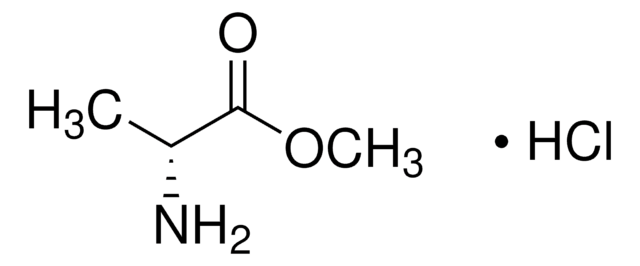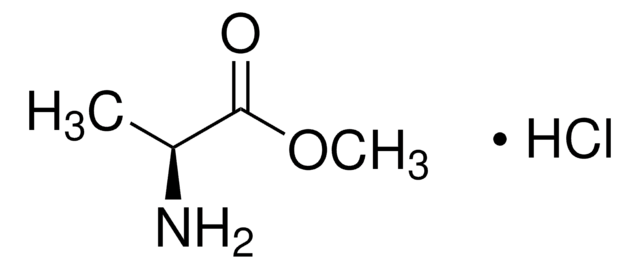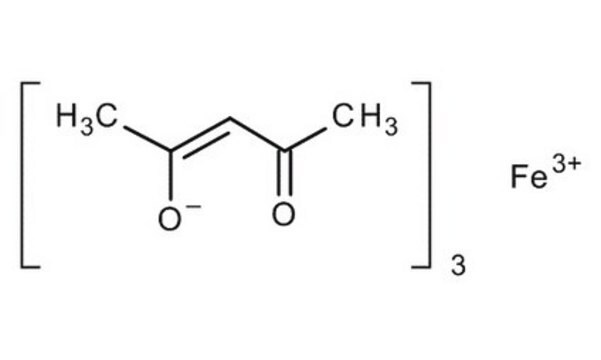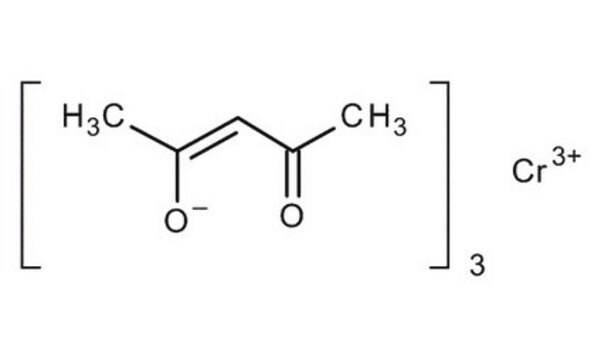Kluczowe dokumenty
517003
Iron(III) acetylacetonate
≥99.9% trace metals basis
Synonim(y):
2,4-Pentanedione iron(III) derivative, Fe(acac)3, Ferric acetylacetonate, Iron(III) 2,4-pentanedionate
About This Item
Polecane produkty
Poziom jakości
Próba
≥99.9% trace metals basis
Formularz
powder
przydatność reakcji
core: iron
reagent type: catalyst
mp
180-182 °C (dec.) (lit.)
gęstość
5.24 g/mL at 25 °C (lit.)
ciąg SMILES
CC(=O)\C=C(\C)O[Fe](O\C(C)=C/C(C)=O)O\C(C)=C/C(C)=O
InChI
1S/3C5H8O2.Fe/c3*1-4(6)3-5(2)7;/h3*3,6H,1-2H3;/q;;;+3/p-3/b3*4-3-;
Klucz InChI
AQBLLJNPHDIAPN-LNTINUHCSA-K
Szukasz podobnych produktów? Odwiedź Przewodnik dotyczący porównywania produktów
Zastosowanie
Hasło ostrzegawcze
Danger
Zwroty wskazujące rodzaj zagrożenia
Zwroty wskazujące środki ostrożności
Klasyfikacja zagrożeń
Acute Tox. 4 Dermal - Acute Tox. 4 Inhalation - Acute Tox. 4 Oral - Eye Dam. 1
Kod klasy składowania
11 - Combustible Solids
Klasa zagrożenia wodnego (WGK)
WGK 3
Temperatura zapłonu (°F)
Not applicable
Temperatura zapłonu (°C)
Not applicable
Środki ochrony indywidualnej
dust mask type N95 (US), Eyeshields, Gloves
Wybierz jedną z najnowszych wersji:
Masz już ten produkt?
Dokumenty związane z niedawno zakupionymi produktami zostały zamieszczone w Bibliotece dokumentów.
Klienci oglądali również te produkty
Produkty
Solwotermalna synteza nanocząstek: zastosowania od nanoobwodów i obwodów nanooptycznych do nanomagnetyki i biotechnologii.
Solvothermal synthesis is a method for preparing a variety of materials such as metals, semiconductors, ceramics, and polymers.
Professor Randal Lee (University of Houston, USA) discusses design considerations for iron oxide magnetic nanospheres and nanocubes used for biosensing, including synthetic procedures, size, and shape. The effects of these variables are discussed for various volumetric-based and surface-based detection schemes.
Nasz zespół naukowców ma doświadczenie we wszystkich obszarach badań, w tym w naukach przyrodniczych, materiałoznawstwie, syntezie chemicznej, chromatografii, analityce i wielu innych dziedzinach.
Skontaktuj się z zespołem ds. pomocy technicznej














